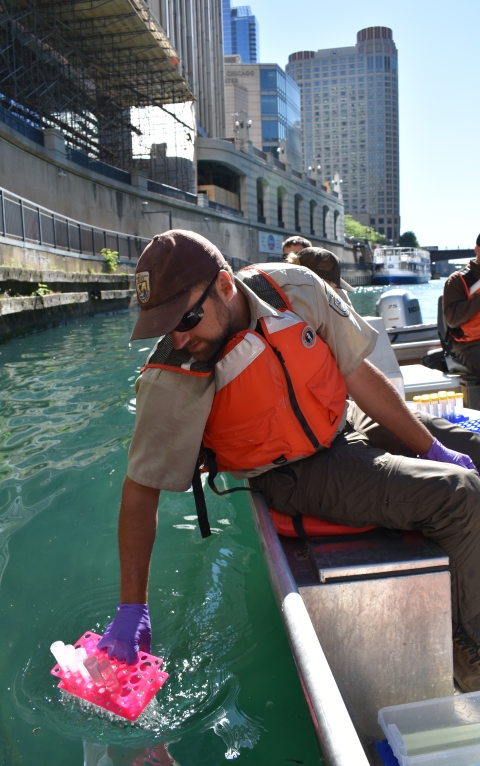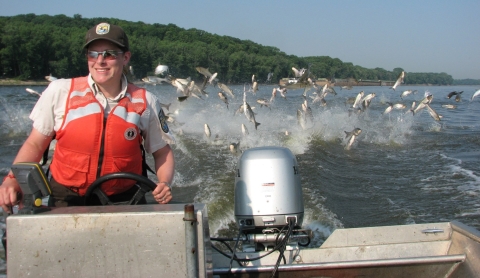About Us
How We Work Together: Three Offices. One Center.
The Midwest Fisheries Center houses three offices: the Whitney Genetics Laboratory, La Crosse Fish and Wildlife Conservation Office, and La Crosse Fish Health Center. The National Wild Fish Health Survey is one example of how we work together. First, the Fish and Wildlife Conservation Offices survey the waterway and capture fish using electrofishing, a technique in which technicians net the fish that rise fish to the surface and place them in a live well on the boat.
Fish are then brought to La Crosse Fish Health Center biologists on shore. After the fish are euthanized humanely, samples are taken from the kidney and spleen. The tissue samples are transported back to the lab where they are cultured for bacterial and viral pathogens using a variety of standard techniques. Depending on the species collected, a fin clip may also be supplied to the Whitney Genetics Laboratory for genetic analysis.
Monitoring waterways for the presence of invasive species invasive species
An invasive species is any plant or animal that has spread or been introduced into a new area where they are, or could, cause harm to the environment, economy, or human, animal, or plant health. Their unwelcome presence can destroy ecosystems and cost millions of dollars.
Learn more about invasive species is another good example where offices at the Midwest Fisheries Center along with other field stations in the Midwest region's fisheries offices within the USFWS Fisheries and Aquatic Conservation program work together. Invasive carp environmental DNA testing to monitor newly invaded habitats starts with field offices, including the La Crosse Fish and Wildlife Conservation Office, collecting water samples across the Great Lakes Basin, the Upper Mississippi, and Ohio River systems. Samples are sent to the Whitney Genetics Laboratoryand the regional Invasive carp/eDNA Coordinator for processing.
The Midwest Fisheries Center reports combine field and lab results for our partners. Monitoring the invasion front to understand reproduction and recruitment of invasive species is done by field stations when they collect fish egg and larval samples. Visual identification of such small organisms is difficult due to damage, but the genetics lab can identify the specimens by their genetic code in small segments of DNA. Currently, the lab uses techniques that provide short DNA sequences for an individual egg or larval fish. In the very near future, the lab will use next generation sequencing techniques to identify hundreds or even thousands of eggs and larval fish in a mixed sample by generating millions of sequences in a single run.
Our Mission
“Working in partnership, we provide leadership in science, technology, and education for conservation of aquatic ecosystems emphasizing fisheries, aquatic invasive species invasive species
An invasive species is any plant or animal that has spread or been introduced into a new area where they are, or could, cause harm to the environment, economy, or human, animal, or plant health. Their unwelcome presence can destroy ecosystems and cost millions of dollars.
Learn more about invasive species , genetics, and aquatic animal health for the benefit of the public.”
Our History
1995 - The La Crosse Fish Health Center and the La Crosse Fish and Wildlife Conservation Office, along with the offices for the Upper Mississippi River National Wildlife and Fish Refuge - La Crosse District, moved to its current location in Onalaska, Wisconsin.
2013 - The Midwest Fisheries Center was established, housing the Whitney Genetics Lab within the La Crosse Fish Health Center along with housing the La Crosse Fish and Wildlife Conservation Office and the Regional Watercraft Safety Coordinator.
2015 - The first Midwest Fisheries Center Director was hired in addition to core administrative and GIS staff.
2018 - The Midwest Fisheries Center lobby was renovated to add more workspace as well as visitor information and displays.
Other Facilities in this Complex
The Midwest Fisheries Center houses the La Crosse Fish Health Center, the La Crosse Fish and Wildlife Conservation Office, the Whitney Genetics Laboratory, and administrative, GIS, and outreach staff, as well as the Regional Watercraft Safety Coordinator.




